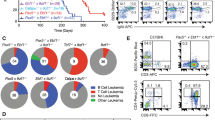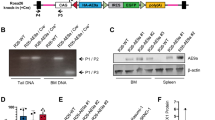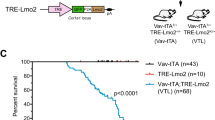Abstract
The t(12;21) translocation, generating the TEL/AML1 fusion protein, is the most common genetic lesion in childhood cancer. Using a bone marrow transplantation model, we demonstrate that TEL/AML1 expression impinges on normal hematopoietic differentiation, leading to the in vivo accumulation and persistence of an early progenitor compartment with a Sca1+/Kithi/CD11b+ phenotype and an increased self-renewal capacity, as documented by replating assays in vitro. Differentiation of these cells is not blocked, but the frequency of mature blood cells arising from TEL/AML1-transduced progenitors is low. Impaired differentiation is prominently observed in the pro-B-cell compartment, resulting in an proportional increase in early progenitors in vivo, consistent with the t(12;21) ALL phenotype. Despite the accumulation of both multipotent and B-cell progenitors in vivo, no leukemia induction was observed during an observation period of over 1 year. These results are consistent with findings in twins with concordant ALL, showing that TEL/AML1 generates a preleukemic clone in utero that persists for several years in a clinically covert fashion. Furthermore, our studies showed that the pointed domain of TEL/AML1, which recruits transcriptional repressors and directs oligomerization with either TEL/AML1 or wild-type TEL, was essential for the observed differentiation impairment and could not be replaced with another oligomerization domain.
This is a preview of subscription content, access via your institution
Access options
Subscribe to this journal
Receive 50 print issues and online access
$259.00 per year
only $5.18 per issue
Buy this article
- Purchase on Springer Link
- Instant access to full article PDF
Prices may be subject to local taxes which are calculated during checkout






Similar content being viewed by others
Abbreviations
- ALL:
-
acute lymphoblastic leukemia
- AML:
-
acute myelogenous leukemia
- AML1:
-
protein encoded by RUNX1
- A/E:
-
AML1/ETO
- CBF:
-
core-binding factor
- eGFP:
-
enhanced gree fluorescent protein
- IL3:
-
interleukin-3
- IL7:
-
interleukin-7
- PTD:
-
pointed domain
- RHD:
-
runt homology domain
- SCF:
-
stem cell factor
- T/A:
-
TEL/AML1
- TAD:
-
transactivating domain
References
Akashi K, He X, Chen J, Iwasaki H, Niu C, Steenhard B, Zhang J, Haug J and Li L . (2003). Blood, 101, 383–390.
Bernardi R, Grisendi S and Pandolfi P . (2002). Oncogene, 21, 3445–3458.
Bernardin F, Yang Y, Cleaves R, Zahurak M, Cheng L, Civin C and Friedman A . (2002). Cancer Res., 62, 3904–3908.
Borkhardt A, Cazzaniga G, Viehmann S, Valsecchi M, Ludwig W, Burci L, Mangioni S, Schrappe M, Riehm H, Lampert F, Basso G, Masera G, Harbott J and Biondi A . (1997). Blood, 90, 571–577.
Christensen J and Weissman I . (2001). Proc. Natl. Acad. Sci. USA, 98, 14541–14546.
de Guzman C . (2002). Mol. Cell. Biol., 22, 5506–5517.
Elefanty AG and Cory S . (1992). Mol. Cell. Biol., 12, 1755–1763.
Erikson P, Gao J, Chang K-S, Look T, Whisenant E, Raimondi S, Lasher R, Trujillo J, Rowley J and Drabkin H . (1992). Blood, 80, 1825–1831.
Fenrick R, Amann J, Lutterbach B, Wang L, Westendorf J, Downing J and Hiebert S . (1999). Mol. Cell. Biol., 19, 6566–6574.
Fenrick R, Wang L, Nip J, Amann J, Rooney R, Walker-Daniels J, Crawford H, Hulboy D, Kinch M, Matrisian L and Hiebert S . (2000). Mol. Cell. Biol., 20, 5828–5839.
Golub T, Varker G, Bohlander S, Hiebert S, Ward C, Bray-Ward P, Morgan E, Raimondi S, Rowley J and Gilliland D . (1995). Proc. Natl. Acad. Sci. USA, 92, 4917–4921.
Gong J . (1978). Science, 199, 1443–1445.
Greaves M, Maia A, Wiemals J and Ford A . (2003). Blood, 102, 2321–2333.
Growney JD, Shigematsu H, Li Z, Lee BH, Adelsperger J, Rowan R, Curley DP, Kutok JL, Akashi K, Williams IR, Speck NA and Gilliland DG . (2005). Blood, 106, 494–504.
Hardy R, Carmack C, Shinton S, Kemp J and Hayakawa K . (1991). J. Exp. Med., 173, 1213–1225.
Hayashi K, Natsume W, Watanabe T, Abe N, Iwai N, Okada H, Ito Y, Asano M, Iwakura Y, Habu S, Takahama Y and Satake M . (2000). J. Immunol., 165, 6816–6824.
Hiebert S, Lutterbach B, Durst K, Wang L, Linggi B, Wu S, Wood L, Amann J, King D and Hou Y . (2001). Cancer Chemother. Pharmacol., 48 (Suppl1), S31–S34.
Higuchi M, ÓBrien D, Kumaravelu P, Lenny N, Yeoh E-J and Downing J . (2002). Cancer Cell, 1, 63–74.
Holtschke T, Löhler J, Kanno Y, Fehr T, Giese N, Rosenbauer F, Lou J, Knobeloch K-P, Gabriele L, Waring J, Bachmann M, Zinkernagel R, Morse III H, Ozato K and Horak I . (1996). Cell, 87, 307–317.
Ichikawa M, Asai T, Saito T, Yamamoto G, Seo S, Yamazaki I, Yamagata T, Mitani K, Chiba S, Hirai H, Ogawa S and Kurokawa M . (2004). Nat. Med., 10, 299–304.
Irvin B, Wood L, Wang L, Fenrick R, Sansam C, Packham G, Kinch M, Yang E and Hiebert S . (2003). J. Biol. Chem., 278, 46378–46386.
Jousset C, Carron C, Boureux A, Quang C, Oury C, Dusanter-Fourt I, Charon M, Levin J, Bernard O and Ghysdael J . (1997). EMBO J., 16, 69–82.
Kitabayashi I, Tokoyama A, Shimazu K and Ohki M . (1998). EMBO J., 17, 2994–3004.
Lagasse E, Shizuru J, Uchida N, Tsukamoto A and Weissman I . (2001). Immunity, 14, 425–436.
Lessard J and Sauvageau G . (2003). Nature, 423, 255–260.
Levanon D, Goldstein R, Bernstein Y, Tang H, Goldenberg D, Stifani S, Paroush Z and Groner Y . (1998). Proc. Natl. Acad. Sci. USA, 95, 11590–11595.
Li Z, Schwieger M, Lange C, Kraunus J, Sun H, van den Akker E, Modlich U, Serinsoz E, Will E, von Laer D, Stocking C, Fehse B, Schiedlmeier B and Baum C . (2003). J. Exp. Hematol., 31, 1206–1214.
Licht J . (2001). Oncogene, 20, 5660–5679.
Lopez R, Carron C, Oury C, Gardellin P, Bernard O and Ghysdael J . (1999). J. Biol. Chem., 274, 30132–30138.
McLean TW, Ringold S, Neuberg D, Stegmaier K, Tantravahi R, Ritz J, Koeffler HP, Takeuchi S, Janssen JW, Seriu T, Bartram CR, Sallan SE, Gilliland DG and Golub TR . (1996). Blood, 88, 4252–4258.
Meyer J, Jücker M, Ostertag W and Stocking C . (1998). Blood, 91, 1901–1908.
Meyers S, Downing J and Hiebert S . (1993). Mol. Cell. Biol., 13, 6336–6345.
Miyoshi H, Kozu T, Shimizu K, Enomoto K, Maseki N, Kaneko Y, Kamada N and Ohki M . (1993). EMBO J., 12, 2715–2721.
Mori H, Colman S, Xiao Z, Ford A, Healy L, Donaldson C, Hows J, Navarrete C and Greaves M . (2002). Proc. Natl. Acad. Sci. USA, 99, 8242–8247.
Morrison S, Wandycz A, Hemmati H, Wright D and Weissman I . (1997). Development, 124, 1929–1939.
Morrow M, Horton S, Kioussis D, Brady H and Williams O . (2004). Blood, 103, 3890–3896.
Muller-Tidow C, Steffen B, Cauvet T, Tickenbrock L, Ji P, Diederichs S, Sargin B, Kohler G, Stelljes M, Puccetti E, Ruthardt M, deVos S, Hiebert S, Koeffler H, Berdel W and Serve H . (2004). Mol. Cell. Biol., 24, 2890–2904.
Okada H, Watanabe T, Niki M, Takano H, Chiba N, Yanai N, Tani Hibino H, Asano S, Mucenski M, Ito Y, Noda T and Satake M . (1998). Oncogene, 17, 2287–2293.
Osato M . (2004). Oncogene, 23, 4284–4296.
Pabst T, Mueller B, Harakawa N, Schoch C, Haferlach T, Behre G, Hiddemann W, Zhang D-E and Tenen D . (2001). Nat. Med., 7, 1–8.
Petrovick M, Hiebert S, Friedman A, Hetherington C, Tenen D and Zhang D-E . (1998). Mol. Cell. Biol., 18, 3915–3925.
Putz G, Rosner A, Nuesslein I, Schmitz N and Buchholz F . (2005). Oncogene submitted.
Randall T and Weissman I . (1997). Blood, 89, 3596–3606.
Romana S, Mauchauffe M, LeConiat M, Chumakov I, LePalier D, Berger R and Bernard O . (1995). Blood, 85, 3662–3670.
Schebesta M, Heavey B and Busslinger M . (2002). Curr. Opin. Immunol., 14, 216–223.
Schwieger M, Löhler J, Friel J, Scheller M, Horak I and Stocking C . (2002). J. Exp. Med., 196, 1227–1240.
Shurtleff S, Buijs A, Behm F, Rubnitz J, Raimondi S, Hancock M, Chan G, Pui C, Grosveld G and Downing J . (1995). Leukemia, 9, 1985–1989.
Smith K, Chanda S, Lingbeek M, Ross D, Botstein D, van Lohuizen M and Cleary M . (2003). Mol. Cell, 12, 393–400.
Speck N and Gilliland D . (2002). Nat. Rev. Cancer, 2, 502–513.
Sun W and Downing JR . (2004). Blood, 104, 3565–3572.
Tenen D, Hromas T, Licht J and Zhang D-E . (1997). Blood, 90, 489–519.
Terskikh A, Miyamoto T, Chang C, Diatchenko L and Weissman I . (2003). Blood, 102, 94–101.
Tsuzuki S, Seto M, Greaves M and Enver T . (2004). Proc. Natl. Acad. Sci. USA, 101, 8443–8448.
van Rompaey L, Potter M, Adams C and Grosveld G . (2000). Oncogene, 19, 5244–5250.
Wang L and Hiebert S . (2001). Oncogene, 20, 3716–3725.
Westendorf J, Yamamoto C, Lenny N, Downing J, Selsted M and Hiebert S . (1998). Mol. Cell. Biol., 18, 323–333.
Yuan Y, Zhou L, Miyamato T, Iwasaki H, Harakawa N, Hetherington C, Burel S, Lagasse E, Weisman I, Akashi K and Zhang D-E . (2001). Proc. Natl. Acad. Sci. USA, 98, 10398–10403.
Zelent A, Greaves M and Enver T . (2004). Oncogene, 23, 4275–4283.
Zhang SL, DuBois W, Ramsay ES, Bliskovski V, Morse III HC, Taddesse-Heath L, Vass WC, DePinho RA and Mock BA . (2001). Mol. Cell. Biol., 21, 310–318.
Acknowledgements
We thank Drs J Cammenga and J Ghysdael for stimulating discussion and the latter for also providing the TEL/Sw plasmid. We also acknowledge the excellent technical support of Marion Ziegler and Karin Heigl, and Arne Düsedau for cell sorting. This work was part of the doctoral thesis of M Fischer, Department of Biology, University of Hamburg, Hamburg, Germany. This work was supported by a grant from the Deutsche José Carreras-Leukemia-Stiftung (RO1/04) and the Frtiz Thyssen Foundation (10.05.1.182). The Heinrich-Pette-Institut is supported by the Freie und Hansestadt Hamburg and the Bundesministerium für Gesundheit.
Author information
Authors and Affiliations
Corresponding author
Rights and permissions
About this article
Cite this article
Fischer, M., Schwieger, M., Horn, S. et al. Defining the oncogenic function of the TEL/AML1 (ETV6/RUNX1) fusion protein in a mouse model. Oncogene 24, 7579–7591 (2005). https://doi.org/10.1038/sj.onc.1208931
Received:
Revised:
Accepted:
Published:
Issue Date:
DOI: https://doi.org/10.1038/sj.onc.1208931
Keywords
This article is cited by
-
RNA binding protein IGF2BP1 synergizes with ETV6-RUNX1 to drive oncogenic signaling in B-cell Acute Lymphoblastic Leukemia
Journal of Experimental & Clinical Cancer Research (2023)
-
The correction of ETV6/RUNX1 translocation in acute lymphocytic leukemia cells: a new gene targeting system by homologous recombination mechanism
Journal of Applied Genetics (2020)
-
A causal mechanism for childhood acute lymphoblastic leukaemia
Nature Reviews Cancer (2018)
-
Molecular processes involved in B cell acute lymphoblastic leukaemia
Cellular and Molecular Life Sciences (2018)
-
The lncRNA CASC15 regulates SOX4 expression in RUNX1-rearranged acute leukemia
Molecular Cancer (2017)



